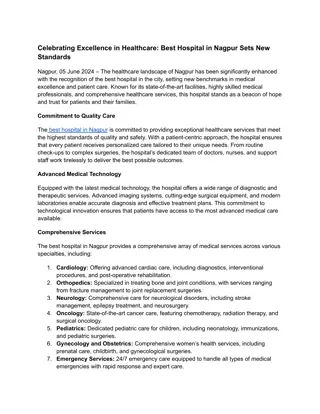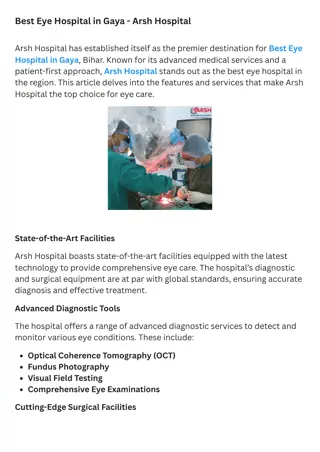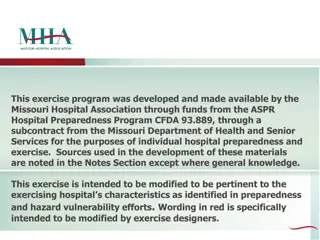Roles and Responsibilities in Hospital Organization
Healthcare reform and increased regulatory matters are transforming hospital care, requiring boards of directors to adapt their leadership structures to ensure financial sustainability and quality care for patients. The board chair plays a crucial role in guiding the board's priorities, strategic plans, and public representation, while fostering a strong relationship with the hospital CEO. Board trustees oversee the hospital's best interests as entrusted by the community. Effective collaboration among board members is essential for the success of hospital infrastructures.
Download Presentation

Please find below an Image/Link to download the presentation.
The content on the website is provided AS IS for your information and personal use only. It may not be sold, licensed, or shared on other websites without obtaining consent from the author. Download presentation by click this link. If you encounter any issues during the download, it is possible that the publisher has removed the file from their server.
E N D
Presentation Transcript
Duties and Responsibilities in Hospital organization Dr Versha Prasad
Responsibilities in Hospital organization Healthcare reform and increased regulatory matters are making healthcare more complex and challenging for board directors than ever before. Hospitals have varying types of leadership structures, depending on their size and whether they are private, for-profit entities or nonprofit government hospitals. In general, hospital care is changing from volume-based care to value-based care, which means that boards of directors need to make major changes in their objectives and strategic goals. In spite of all of the changes, boards must continue to focus their top priorities on financial sustainability for the hospital and quality of care for their patients.
Responsibilities in Hospital organization Boards design their leadership structures to fill all of the needs of the organization efficiently. Each role has a specific job description with expectations for duties, responsibilities and boundaries. The collaboration between the people in those roles is what makes it all work for the good of the patients, shareholders, stakeholders and employees. Here is a general overview of how hospital infrastructures work.
Roles and Responsibilities of the Chairman of the Board The board chair is a member of the board of trustees. The person filling this role presides over board and executive committee meetings. The board chair has many duties. One of the primary duties is to guide the board s work by steering the board s priorities, annual objectives and strategic plans. Serving as the hospital s public spokesperson, the board chair is the voice of the board to hospital staff, stakeholder groups and the community at large. As a leader, the board chair serves the best interests of the organization and the board, placing their own interests aside.
Roles and Responsibilities of the Chairman of the Board Typically, the board chair develops a special relationship with the hospital CEO. The board chair offers the CEO advice about governance matters and garners support for the CEO from the rest of the board. Regular communication between the board chair and the CEO facilitates the setting of clear goals and objectives, which the CEO then communicates to upper management. The board chair has many responsibilities to the other board members, including recruitment, orientation, and board mentoring and development. The board chair is an ex-officio member of all committees. In this role, the board chair designates committees and appoints committee chairs.
Roles and Responsibilities of the Board of Trustees The board directors of hospitals are sometimes referred to as trustees because the owners and community entrust them with overseeing the hospital s best interests. The board of trustees is the governing body of the hospital. They are responsible for developing and reviewing the hospital s overall mission and strategy. The board guides the long-term goals and policies for the hospital by making strategic plans and decisions. The board of trustees doesn t get involved in managing the hospital s activities; rather, they oversee them.
Roles and Responsibilities of the Board of Trustees As part of their oversight duties, the board of trustees sets the job description for the CEO and is responsible for hiring, firing and monitoring the CEO. The board typically sets clear goals and expectations for the CEO, in keeping with strategic planning. Trustees assist and support the CEO with input about management policies, procedures and decisions. Upper management, along with human resources, is responsible for hiring hospital staff. Board trustees oversee the employee credentialing process, making sure healthcare professionals have the proper training, licensing and accreditation. The board is also responsible for making sure that processes are in place to discover any history of disciplinary action by prospective employees and to ensure that they have the proper level of malpractice insurance.
Roles and Responsibilities of the Board of Trustees Hospital trustees are charged with duty of care, which means that they must oversee the hospital s financial health and sustainability. They must also make sure that the hospital makes the best use of the resources it has. Hospitals provide a vital community service, so it s important for board trustees to oversee the highest quality of care. Board trustees need to stay abreast of the latest in industry news and best practices. Trustees represent the hospital within the community, so it s important for them to understand the needs of their community and to respond with outreach efforts and education. Hospital boards must engage in self-regulation by performing regular self- evaluations on themselves, their peers and the whole board.
Roles and Responsibilities of the Company Secretary As in many other industries, the role of the company secretary is evolving into one of primary importance. In fact, some governance experts favor a title change from Secretary to Chief Governance Officer. Many hospitals are lagging behind the times, marginalizing the secretary and deeming them as little more than a note-taker and file clerk. With major changes in governance taking place, company secretaries are the prime people to champion governance expertise for their boards. Company secretaries work closely with the board chair and the CEO when recruiting, electing or appointing new board members. They also assist the board chair with recruiting and selecting committee chairs and committee members. The secretary often serves as the committee chair for the governance committee.
Roles and Responsibilities of the Company Secretary Secretaries also take on much of the responsibility for orienting board members and arranging mentors and continuing education for them. As needed, the company secretary also helps the board perform self- evaluations. The secretary also takes a primary role in working with the board chair to address dysfunctional or non-participatory board trustees. As a matter of practicality, the company secretary maintains official hospital records, including the articles of incorporation, bylaws, voting records, and the board s policies, procedures and protocols. The secretary works with the board chair to set and distribute agendas and board packets prior to board meetings. In addition to these important duties, the secretary assists the board chair in fulfilling his or her responsibilities.























